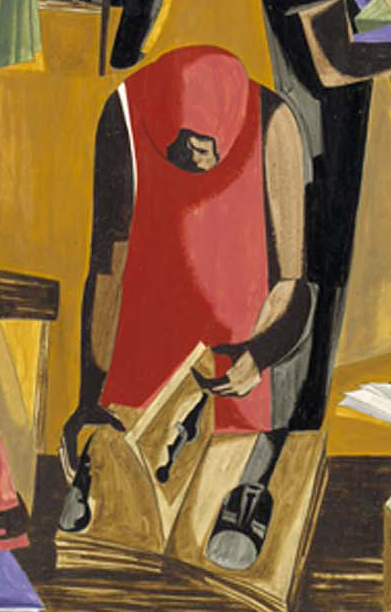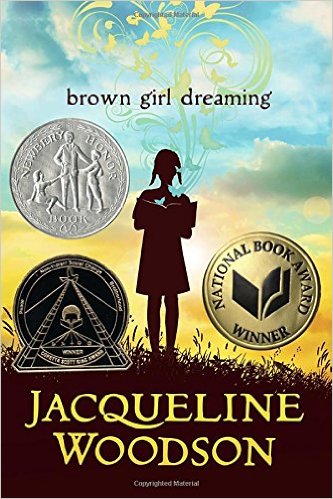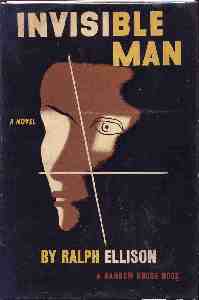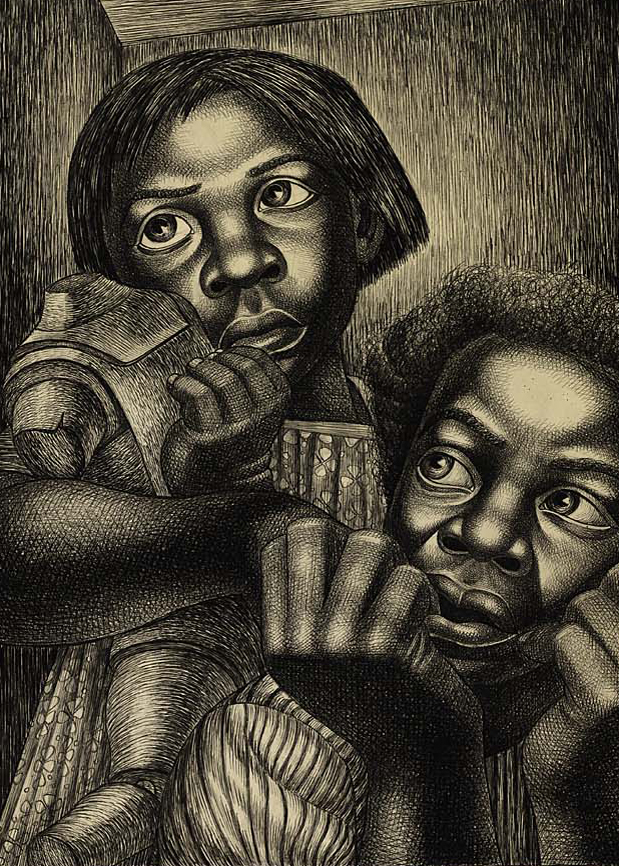The fight for equal rights, basic rights like equal education, were brought to the forefront of America’s attention during the African American Civil Rights movement of the 1950s and 60s. Just as we saw in the Civil War-era work The Lord is My Shepherd, which depicted a newly emancipated black man reading the Bible, here too, in the depiction of African Americans reading in a library we are reminded that the ability to read, to educate oneself is the ultimate form of empowerment and best tool with which to combat oppression. The two African Americans shown in a cramped confined space are visually and literally restricted, both by horizontal barriers and by their status as minorities in the 1950s. The work alludes to the lack of opportunities and education open to blacks. The landmark decision of the Supreme Court in the case Brown v. Board of Education in 1954 helped begin to heal discriminatory divides. The court declared separate public schools unconstitutional, stating that “separate educational facilities are inherently unequal.”
Download a Teaching Poster PDF of The Library
Activity: Observe and Interpret
The Children
Artists make choices in communicating ideas. Charles White is a leading African American artist of the twentieth century. He is best known for the masterful drawings he created throughout his career. What message is Charles White trying to convey in this drawing? What can we learn about African American life following the conclusion of World War II through this artwork? Observing details and analyzing components of the artwork, then putting them in historical context, enables the viewer to interpret the overall message of the artwork.
Observation: What do you see?
What are the figures looking at? What could they be thinking about?
In this intense composition, two figures stare out of a narrow window, both gazing upward. Charles White’s drawing exudes an anxious, uneasy mood. He carefully renders the figures so that viewers identify with their apprehension. The African American girl in the background clutches a doll hoping it can provide her with solace. The doll’s headless and armless body serves as a symbol of the girl’s thwarted ambition and lack of opportunity. She looks outside the window, perhaps wondering what is to become of her. The figure in front of her—perhaps an older brother—holds up large, powerful hands to his face, another sign of worry. He looks out the window, speculating about her future in a world filled with adversity for people of their race. Although they inhabit the same space and glance in a similar direction, they seem detached from one another, as if their worries isolate them. Compressing the figures behind the window’s flat surface, White makes the pair’s agitation and forlornness palpable. The artwork captures the post-World War II anxieties and adversity faced by black Americans, expanded on by black veterans returning home to a world lacking in opportunity.
How does the artist create tension?
The figures are locked tightly in a cropped space, their movement cramped by the edges of the window. The lack of depth behind them, along with the restrictive horizontal bars in front of them, further hem them in physically. It is conceivable that the lives of these two figures are also barred by restrictions imposed on African Americans during the 1950s; restrictions such as segregated public facilities and a lack of opportunity in education and employment. The drawing is made with thousands of fine lines and crosshatching, that infuse the composition with movement and tension. For White, the late 1940s and early 1950s were a deeply anxious time. As a left-wing artist who associated with progressives and members of the Communist Party, he felt the constant threat of political persecution, especially after the McCarran Act of 1950 criminalized activities perceived to be subversive.
Interpretation: What does it mean?
While White’s art may convey some of his personal anxieties, he relates his work to social issues of particular importance to African Americans, seeing himself as a “spokesman for my people.” Around 1950, when White created this drawing, school desegregation had become the prevailing civil rights issue for many African American families. Returning black WWII veterans who had and risked their lives serving their country, now found that they had to send their children to segregated and terribly inadequate schools. This issue may also have been especially significant to White, who married and began his own family that year. Since the 1930s, thousands of African Americans had joined protests against school segregation. Yet in 1950, civil rights leaders used new tactics to show that segregation was not simply unfair but also psychologically damaging to black children. To provoke legal battles, these leaders encouraged black children in certain communities to try to attend all-white schools, knowing they would be turned away. Five key cases began to make headlines in 1950 and culminated in the 1954 landmark Supreme Court decision, Brown v. Board of Education, which ruled school segregation illegal. White’s drawing may not be a direct commentary on the issue of school desegregation, yet by portraying two African American children within a confined, tense space, White seems to register the psychological torment African American families endured during the era of segregation.
The Library
Artists make choices in communicating ideas. What information can we learn about the African American experience in Harlem from this painting? What clues does Jacob Lawrence give us? Observing details and analyzing components of the painting, then putting them in historical context, enables the viewer to interpret the overall message of the work of art
Observation: What do you see?
 How would you describe the setting and the people shown in this painting?
How would you describe the setting and the people shown in this painting?
The books, desks, and people reading tell us that the scene depicted is in a library. A group of African American men and women sit and stand in a brightly reading room. They are not speaking to one another or looking around the room – they are completely absorbed in their reading, seemingly oblivious to the other people around them. The standing figure in the foreground, looking through a book of African sculpture, may represent the artist, Jacob Lawrence, himself. Libraries played a critically important role in Lawrence’s artistic development, offering him a facility where he could learn about the lives of civil rights leaders and abolitionists such as John Brown, Harriet Tubman, and Frederick Douglass, all of whom became subjects of Lawrence’s work.
What is the mood of the artwork? How does the artist achieve this?
The bright colors and patterns suggest that the library is a busy, but happy place to be. The bright, flat colors and decorative patterning in The Library are likely nuanced references to African kente cloth. It first appeared in Ghana in the seventeenth century and has traditional ceremonial usage. The word kente means “basket” or “woven cloth” in the Akan or Ashanti dialect, and is made of narrow strips of fabric woven together to form patterns. The designs, colors, and patterns each have their own special meanings and stories. During the 1960s the bright colors and patterns of kente cloth were appropriated as an emblem of the Black Pride movement – wearing kente cloth was, and still is today, worn by African Americans as a representation of pride in one’s ancestors and African heritage.
Interpretation: What does it mean?
This colorful view of a crowded reading room depicts readers absorbed in research at the 135th Street Library in New York City’s Harlem neighborhood. The library, now the Schomburg Center for Research in Black Culture, was frequented by artist Jacob Lawrence as a young man. Lawrence, who grew up in Harlem, recalled that in high school, black culture was “never studied seriously like regular subjects,” and so he spent a lot of his time at the 135th Street Library and museums to teach himself about black culture and history.
Painted three years after school de-segregation in 1957, The Library serves to remind African Americans of the importance of education and in remembering and preserving their African history and culture in the wake of school de-segregation. During the Civil Rights Movement, libraries, like the 135th Street Library the artist frequented as a young man, provided safe learning spaces for African Americans to study their history and culture when it was not part of the curriculum taught in integrated classrooms throughout the country.
Historical Background
After the War: Blacks and the G.I. Bill
For many black American veterans, coming back home after the war became a period of difficult transition. The treatment blacks received in Europe was much different than the racism and prejudice they had experience in America. In Europe they had been treated just like any other soldier, the color of their skin was not a consideration. One young soldier commented, “Had the ten months I spent in France been all in vain? Were those white crosses over the dead bodies of those dark-skinned boys lying in Flanders fields for naught? Was democracy merely a hollow sentiment? What had I done to deserve such treatment?” This fundamental shift in treatment raised hope and expectation that things would be different once they returned to American soil. A metaphorical reading of Untitled by African American artist Charles White suggests that the two African American figures are barred from participating in the society which they are able to view from their window. The two boards across the narrow window restrict the two figures within the space of the composition. This artwork, created in 1950, captures the anger, unease, and sense of displacement that would feed the civil rights movement of the late 1950s and 1960s.
The effects World War II had on the lives of African Americans were viewed both as successful and unsuccessful. After the war all branches of the military committed to review their policies for racial integration, yet racism and prejudice ran rampant in many areas of civilian life. Some black soldiers did not find their service to be a satisfactory experience yet others noted that they gained skills, an education and the chance to experience life outside of the United States. When they returned home, the G.I. Bill, or the Servicemen’s Readjustment Act of 1944, sought to provide returning service members with many benefits. Among these benefits were low-cost mortgages, high school or vocational education, payments for tuition and living expenses for those electing to attend college, and low-interest loans for entrepreneurial veterans wanting to start a business. These benefits were open to all veterans, including those honorably discharged, who had served at least 120 days of active duty (combat duty was not required). The bill not only helped individual service members, but also stimulated long-term economic growth. Though the law was deemed a political and economic success, there was one segment of veterans who were denied many of the bill’s benefits – African Americans.
One of the more important benefits that African American service members were unable to take advantage of were low-cost mortgages. In theory, this benefit allowed all veterans to purchase homes in the quickly growing suburbs, homes whose value would rise steadily in the coming decades, creating new wealth for vets in the post-war era. However, black veterans were not able to take advantage of this benefit because banks would not make loans for mortgages in black neighborhoods. Additionally, they faced rampant racism if they attempted to buy into suburban neighborhoods, which at the time were overwhelmingly white. See Urban to Suburban for more information on this topic.
Unemployment benefits were also a major problem. Under the G.I. Bill, veterans were guaranteed one year of unemployment compensation. Many industries had opened up skilled labor positions to blacks during the war, but post-war many of them returned to the practice of hiring blacks for only low-wage jobs. When these lower wages, which were below average subsistence levels in the United States, were turned down by blacks, the Veteran’s Administration (VA) was notified that they had been offered a job and didn’t take it, so their unemployment benefits were terminated. Arguably the greatest benefit blacks were able to take advantage of was the payment for college-level education. Many prospective students elected to attend historically black colleges, but a few pioneers ventured into unchartered territory, attending primarily white universities and opening the doors to integration and school desegregation.
Literary Connections
 brown girl dreaming, 2014, Jacqueline Woodson
brown girl dreaming, 2014, Jacqueline Woodson
Find it in a Library
brown girl dreaming is the story of the author’s childhood, growing up in South Carolina and New York. Written as a series of poems, the authors shares what it was like for her to grow up as an African American child in the 1960s and 1970s. The poems address her growing awareness of the Civil Rights Movement and finding her voice through her writing. The following is an excerpt:
I am born as the South explodes,
too many people too many years
Enslaved, then emancipated
But not free, the people
Who look like me
Keep fighting
And marching
And getting killed
So that today–
February 12, 1963
And every day from this moment on,
Brown children like me can grow up
Free. Can grow up
Learning and voting and walking and riding
Wherever we want.
 Invisible Man, 1952, Ralph Ellison
Invisible Man, 1952, Ralph Ellison
Find it in a Library
A milestone book in African American literature, Invisible Man is a first-person account of a young black man’s experiences growing up in a Southern black community, attending college, and moving to New York. The unnamed man claims that he is an “invisible man,” that is that others refuse to “see: him because he is African American.
Listen to Ralph Ellison describe his process of discovery as he worked on Invisible Man
“(Harlem) A Dream Deferred” 1951, Langston Hughes
Read it at PoetryFoundation.org
In 1951, the year of the poem’s publication, the mood characterizing American blacks was frustration. Despite the passage of laws which enabled blacks to vote and to own property, there remained a continued prejudice against blacks which effectively relegated them to second-class citizenship. They were not afforded the same opportunities in education or in employment as whites. Schools were segregated and poorly equipped without proper supplies, employment opportunities were relegated to menial jobs such as shoe-shiners, ditch-diggers, porters, and domestic servants. By the 1960s, the frustration had reached a boiling point, foreshadowed by Hughes in the last line of his poem.
What happens to a dream deferred?Does it dry uplike a raisin in the sun?Or fester like a sore—And then run?Does it stink like rotten meat?Or crust and sugar over—like a syrupy sweet?Maybe it just sagslike a heavy load.Or does it explode?
Artwork Connections
Mrs. James Smith and Grandson, 1776, Charles Willson Peale
While centuries apart, Untitled and Mrs. James Smith and Grandson share striking similarities. The mature figures in both artworks express worry over the future the younger figures, either through facial expression or through particularly placed symbolic pictorial elements. Both artworks were created during a time of great change and uncertainly; one in the years just prior to the Civil Rights Movement of the 1960s and the other at the height of the American Revolution. To learn more about Mrs. James Smith and Grandson, visit We the People…
Identification Manual, 1964, Larry Rivers
Identification Manual combines phantom images of murdered civil rights marchers with pictures of beautiful black women and products designed to bleach dark skin. On the right, two sliding panes of glass afford different racial identities to a figure of a woman.
A white artist (Rivers) creating racially explicit art in the 1960s was controversial, and Rivers liked to give his works clinical, deadpan titles that made the images even more shocking. Identification Manual conveys the difficulty faced by blacks and whites trying to find their way through the heated conflicts of the civil rights movement. A quotation from Lord Acton, a famously liberal historian in nineteenth-century England, accompanied the title. It read: “The most certain test by which we judge whether a country is really free is the amount of security enjoyed by minorities.”
SOB, SOB, 2003, Kerry James Marshall
SOB, SOB evokes Marshall’s intellectual journey over the last fifty years beginning with his boyhood visits to the local library. According to the artist, by the third and fourth grades he knew “every single art book in the library,” and by the seventh grade he was taking summer classes at the Otis Art Institute. SOB, SOB reflects this thirst for information. It is a painting about the accumulation and dissemination of knowledge, and relates closely to Marshall’s ongoing exploration of African American history. The painting depicts a female figure seated in front of a tall shelf of African history books. A volume titled Africa since 1413 lies at her feet as she gazes into the sunlit interior. It’s unclear whether her contemplative gaze is one of wistful longing for a pre-colonial past or anguish over the transformation of the African continent that began in 1413 with European expeditionary missions. A thought bubble floating above the girl’s head further complicates this emotional ambiguity. The text can be read as either a cry of despair or a pointed expression of anger.
Media
Civil Rights and the 1950s: Crash Course US History – PBS (12 min) TV-G
This video teaches you about the early days of the Civil Rights movement. The 1950s were a time of economic expansion, new technologies, and a growing middle class. While the white working class saw their wages and status improve, blacks were largely excluded from the prosperity of the 1950s. Segregation in housing and education made for some serious inequality for African Americans.
Equal Protection: Crash Course Government and Politics – PBS (8 min) TV-G
This video discusses the most important part of the Constitution – the 14th Amendment. In particular, it discusses the “equal protection” clause and how it relates to our civil rights; the process the Supreme Court follows in equal protection cases, called strict scrutiny; and the landmark case, Brown v Board of Education, and its role in starting the Civil Rights Movement of the 1960s.
Additional Smithsonian Resources
Exploring all 19 Smithsonian museums is a great way to enhance your curriculum, no matter what your discipline may be. In this section, you’ll find resources that we have put together from a variety of Smithsonian museums to enhance your students’ learning experience, broaden their skill set, and not only meet education standards, but exceed them.
Subject: Art
African American Art: Harlem Renaissance, Civil Rights Era, and Beyond – Smithsonian American Art Museum
A selection of paintings, sculpture, prints, and photographs by forty-three black artists who explored the African American experience from the Harlem Renaissance through the Civil Rights era and the decades beyond, which saw tremendous social and political changes.
Subject: History
Document Deep Dive: A Play-by-Play of the March on Washington – Smithsonian Magazine
Subject: Music
Voices of Struggle: The Civil Rights Movement, 1945 to 1965 – Smithsonian Folkways
We honor African American history and music with a look at the profound cultural contribution of the Civil Rights Movement, called by Guy Carawan “the greatest singing movement this country has experienced.” The African American struggle for civil rights and equality inspired the many other socio-political movements in the USA and around the world.
Lesson Plans and Student Activities
Separate is Not Equal: Brown v. Board of Education – Smithsonian National Museum of American History
Document-Based Question: The March on Washington (PDF) – Smithsonian National Museum of American History
Using the provided supporting documents, the historical background, and their own prior knowledge, students are asked to write a persuasive essay that takes a position debating the importance of grassroots organizing and charismatic leadership during the March on Washington.
Glossary
G.I. Bill: formally known as the Servicemen’s Readjustment Act of 1944, the act provided a range of benefits to returning World War II veterans.
McCarran Act of 1950: this federal law, sponsored by Senator Pat McCarran (D), was enacted in response to growing domestic anti-Communist fears. It strengthened laws against espionage, limited free speech for national security reasons, and allowed for the investigation and deportation of immigrants accused of promoting Communism or engaging in subversive activities. The law is also known as the Internal Security Act of 1950 or the Subversive Activities Control Act of 1950.
Veteran’s Administration: this is the benefits arm of the United States Department of Veterans Affairs, the government agency formed in 1930.
Standards
U.S. History Content Standards Era 9 – Post War United States (1945-early 1970s)
- Standard 1A –The student understands the extent and impact of economic changes in the postwar period.
- 9-12 – Analyze the continued gap between poverty and the rising affluence of the middle class.
- Standard 1B – The student understands how the social changes of the postwar period affected various Americans.
- 5-12 – Evaluate the effects of the GI Bill on American society.
- 9-12 – Examine the rapid growth of secondary and collegiate education and the role of new governmental spending on educational programs.
- Standard 3A –The student understands the political debates of the post-World War II era.
- 9-12 – Evaluate Truman’s continuation of New Deal policies in labor relations, housing, education, and health.
- 7-12 – Assess the effectiveness of the “Great Society” programs.
- Standard 4A –The student understands the “Second Reconstruction” and its advancement of civil rights.
- 7-12 – Explain the origins of the postwar civil rights movement and the role of the NAACP in the legal assault on segregation.
- 5-12 – Evaluate the Warren Court’s reasoning in Brown v. Board of Education and its significance in advancing civil rights.
- 5-12 – Explain the resistance to civil rights in the South between 1954 and 1965.
- 7-12 – Assess the role of the legislative and executive branches in advancing the civil rights movement and the effect of shifting the focus from de jure to de facto segregation.




